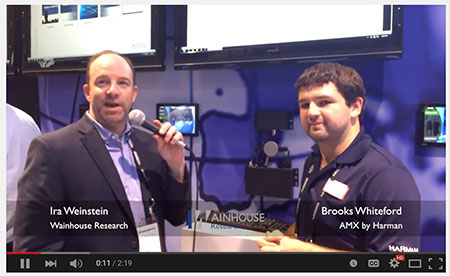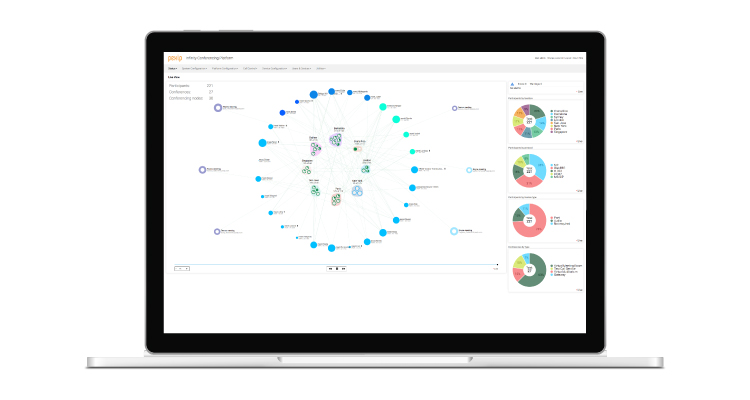Wainhouse Research at InfoComm 2015 (2 of 4)
 By Ira Weinstein
By Ira Weinstein
Sr. Analyst, Consultant and Partner, Wainhouse Research
The WR video conferencing / AV team took InfoComm 2015 by storm. For those of you keeping track, this is Ira’s 26th (yes — not a typo) InfoComm. As always, InfoComm provides access to a wealth of information about products, services, and companies… as well as the chance to catch up with old friends.
As always, we tried to meet with as many companies as possible during this far-too-short event. Our write-up represents what we saw and deemed interesting. This is not to say that other companies did not have something interesting to say at the event… it just means that we didn’t have a chance to drop by.
Huddle Solutions and Wireless Presentation Systems
At InfoComm 2015, we saw a large number of products that vendors referred to as “huddle room” solutions or systems. Given the varying form factors and features included in these devices, it is clear that the criteria for calling something huddle-room ready or optimized have yet to be defined. We, of course, have our own thoughts in this area. But for now, we will simply describe what we saw at the show.
Phoenix Audio Technologies announced (but did not demo) a new audio device called Condor, which the company is positioning as an all-in-one audio system. Condor is essentially a wall-mounted multi-microphone array that looks like a sound bar, but does NOT include speakers. According to the company, Condor creates audio beams into the room that zoom in and pick up any voice up to thirty feet away. The unit includes analog, USB, and optical interfaces that allow it to connect to standard video conferencing systems or integrated audio devices. Condor also includes a built-in SIP phone controlled using an app on a mobile device.
QSC showed the newly announced Q-SYS Core 110f DSP product, which is a mash-up of a software-based audio DSP and AV control system. Intel-based and running Linux, the 110f allows users to connect microphones and speakers, and provides a USB connection to a computer (for BYOD applications). The system includes 16 USB input channels and 16 USB output channels that are software configurable, providing support for a wide range of applications and environments. The 110f is controlled using up to eight optional programmable QSC touch panels. The touch panel acts as the AV user interface, and includes a USB connection used for audio in/out from laptops and mobile devices. QSC did not provide any pricing information at the show. While we haven’t tested the 110f yet, we are both intrigued and confused by this offering. A software-controlled DSP is certainly interesting. However, the concept of a combined DSP and AV control system may or may not make sense (depending on the situations / requirements). Also we question whether a high-end DSP will be needed within (or fit within the budgets of) many huddle rooms.
WR has tested the AMX Enzo product in our lab in the past, with solid results. At this year’s show, AMX demonstrated several new Enzo features. The first is a new moderator mode that allows the moderator / host to select which users’ content should be displayed on screen. In addition, Enzo now supports up to four simultaneous content items on screen. Furthermore, Enzo can now receive and playback H.264 media streams — either from an AMX streaming device or a third party encoder. Check out Ira’s discussion with AMX.
The huddle room was alive and well at the Arrive Systems booth. The AAP-1011-BYMG wireless presentation system (MSRP U.S. $695) supports 1080p/60 video sharing plus audio, offers a single HDMI output, and supports native sharing (without a client download) for iOS, Mac, Android, and Windows 8.1 devices and systems. The 1011 can operate independently (leveraging integrated hot-spot functionality to create its own Wi-Fi network) or over the customer’s LAN. The AMP-1041-BYMG (MSRP U.S. $1,400) combines wireless presentation and a built-in switcher to allow users to choose between wireless presentation content, a VGA input, an HDMI input, and a display port input. In addition, Arrive was showing a new USB speakerphone, a pan / tilt wide-angle camera, and a pan / tilt / zoom camera. Arrive also showed us its InfoPoint Room Scheduler offering which includes a central server and displays mounted outside each meeting room that show the room’s free / busy status and allows immediate booking of the space. Finally, Arrive demo’d the Facepoint solution, a windows-based control system that supports third party collaboration applications including Microsoft Lync, Cisco Jabber and Polycom RealPresence Desktop.
WR was pleased to participate in the Crestron Press Tour. Highlights of the event included a demonstration of 3D image support (Revit files) in the newest release of Crestron Fusion, the Crestron Certified Room Design program allowing integrators to install pre-defined and tested room configurations without the need for custom control programming, and a proof of concept (POC) of the integration of Crestron and Microsoft Surface Hub.
Follow me on Twitter at @iweinstein.





